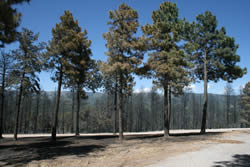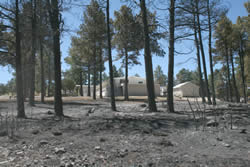
National Fire Plan Success Story
Landowner Creates Defensible Space - Saves Family Home
Lincoln National Forest, New Mexico
National Fire Plan - Fuels Reduction
2009
When we think of heroes in the wildland firefighting front, our first thoughts often go to those who are on the front lines: volunteer fire department personnel, emergency medical technicians, and the many wildland firefighting crews that come from the federal and state agencies in New Mexico. In addition, there are other unsung heroes on the wildland fire front: the homeowners that prepare themselves and their property for extreme fire events. Don and Ruby Roberts are two such heroes to several firefighters for creating a safe working environment during the recent Timberon Fire in the Sacramento Mountains of southeastern New Mexico.
For more than 30 years, the Roberts had been anticipating and planning for a major fire event. Long before the phrases “defensible space” and “Firewise” were coined, this couple was proactive in preparing their home from the threat of wildfire. The combination of dense brush, rocky terrain, and several years of fire suppression had created a dangerous wildfire hazard in this remote community. The Roberts’ recognized that it was up to them to mitigate the wildfire risks and protect their home, taking responsibility to make positive changes.
The work on the property was gradual. The Roberts began evaluating their property every year since 1979. They determined which trees to limb up and which to remove. The results were beautifully spaced trees in the 200 feet surrounding their home all limbed up, 20 feet from the ground, thereby, removing the potential for ladder fuels to spark a crown fire. The work did not diminish the aesthetics of the property; on the contrary, it was enhanced, opening the landscape and providing a better view of the surrounding mountains.

Due to the spacing and limbing work, the fire became less intense when it dropped to the ground after reaching the trees on their property.

The Roberts' home was able to withstand the brunt of the oncoming wildfire, sustaining minimal damage.
The Roberts were tested on the afternoon of May 6, 2009, when the Timberon Fire roared through the southwest portion of this small community. The residents and firefighters described the fire behavior as wind driven and unpredictable in its movements. The rate of spread was also dramatic, speeding through the neighborhood as a crown and ground fire, reaching the Roberts’ property within minutes of being reported to the Timberon Volunteer Fire Department. Due to the spacing and limbing work that was completed, the fire became less intense when it dropped to the ground after reaching the trees on their property. The result was their home was able to withstand the brunt of the oncoming wildfire, sustaining minimal damage. (The siding on the house did sustain damage because of radiant heat from the fire.)
The beneficial work the Roberts’ accomplished helped the men and women who responded to the fire. When a fire of this type and intensity strikes, it will often scale upwards through low limbs and dense brush to the crowns of trees. When this happens, it creates a volatile situation of highly intense flames, making it impossible for firefighters to engage. In the case of the Roberts, the work they completed caused the fire to drop to the ground, allowing firefighters a safe place to work and make a direct attack on the flames. Many of the firefighters praised the Roberts’ efforts, because their work provided a safety zone during the severe moments of the fire.
There are many types of natural disasters such as floods, hurricanes, tornadoes, or landslides. Unlike wildland fire, it is difficult to predict how these types of events will affect structures on private property. You can greatly improve the odds of saving your home by creating defensible space. The Roberts’ work shows people can have some control over the natural elements. Actions taken to mitigate a wildfire on private property can make a critical difference of whether or not your home survives a wildfire. When living in a fire prone environment, it is necessary to take the appropriate steps to identify fire hazards and fuels reduction projects, which can lessen the wildfire damage.
Contact: Susan Jenkins, (208) 839-2110; Joe Garcia, (575) 434-7200.